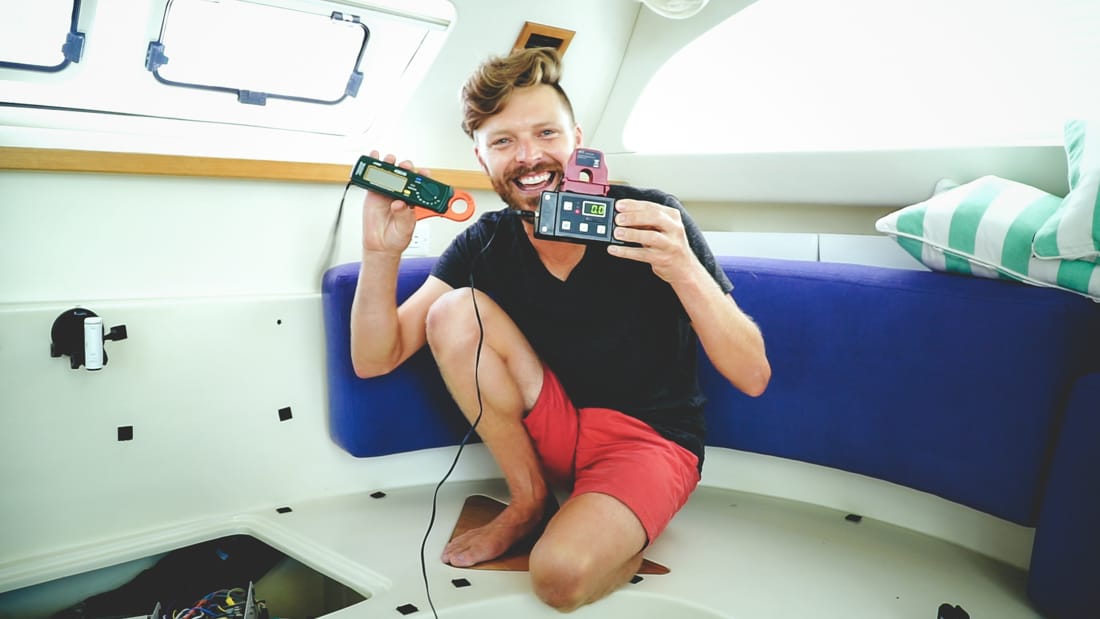Air Conditioning on A Sailboat? Yes, and It’s Battery Powered too!

Air Conditioning on a sailboat is a luxury. Especially when we’re at anchor and running everything off solar and battery power. So, naturally, we get asked about keeping cool on the hook…a lot.
In our last video about sailing with family, I asked Jason’s sister Lauren “how was it coming from a typical house to sleeping in a boat with no air conditioning?”. This question caused a ton of confused comments on why we didn’t run our A/C for the family. Fair enough.
The short answer is, we did run the A/C for short stints, but not overnight. The complete answer to that question is hashed out in the video below. So….click that play button!
Kinda cool right?! Ok, now about those details.
Here’s a quick recap of what we covered in the video:
- Why didn’t you run the A/C? We did in the afternoons, when the sun was high (and our solar panels were bringing in lots o’ power to the batteries). It was the hottest part of the day and it’s o-so-nice to circulate air and bring down humidity.
- Why not run the A/C overnight? We don’t have enough battery power to run the A/C all night and keep up with all the other power demands of the boat. (It’s a challenge to manage resources with 5 additional people who are not accustomed to living with limited resources).
- Why not run the generator? 10 hours of generator uses about 5 gallons of fuel. That fuel consumption adds up fast and requires us to service the generator more often. Not to mention there were no fuel stations where we were anchored. Conserving fuel, parts and our limited resources is important while living off the grid, especially in remote places.
- How do we run the A/C off our batteries? Short answer is, we installed an Easy Start.
How We Run Our Sailboats Air Conditioning off Battery Power
If you want to run the A/C while you’re living off the grid and on the hook, there’s a few things to consider:
- A/C’s use a ton of power. You’ll need a big battery bank to run the A/C for any reasonable length of time. We have a beefy 1200 Amp hours of lithium battery power. More on lithium batteries: gonewiththewynns.com/sailboat-tech-why-lithium-batteries
- Replenish the battery bank. Our 1400 watts of solar has the potential to replenish most of the A/C’s consumption during peak sun hours. But conditions must be perfect, and we need to limit the other electronics we use while the Air Conditioning is on. More on our solar set up here: gonewiththewynns.com/living-off-grid-rv-sailboat
- Inverters have a “surge” or “peak” load. You’ll need to look at the “locked rotor amps” of the A/C to determine if your inverter (or generator/shore power connection) can handle the surge. Our Cruisair 16,000 BTU A/C states it has a peak of 70 amps when the compressor kicks on. Our inverter can handle a max of 60 amps (noted as “Peak Output Current” from the manufacturer spec sheet). So, the surge from the A/C is greater than what our inverter can handle. Plus, that kind of surge is harsh…there are additional benefits to softening the blow (puns intended!). More on our inverter here: gonewiththewynns.com/product/2000-watt-inverter
For reference here are a few common inverters and their claimed peak amps:
- GoPower! IC2000 – 60 amps
- Magnum MS2012 – 50 amps
- Xantrex PROsine 1800 – 45 amps
We’re not reinventing the wheel. This type of power surge is a common problem with all different types of compressors and pumps. That’s how we found the Easy Start. The RV air conditioner manufacturer told us it was the solution to our “surge” issue. The Easy Start is a device that gets attached to the A/C and reduces the surge of power (as you saw in the video). An Easy Start can be used to run an Air Conditioner (or other compressor or pump) off a small generator (like the Honda 2000), low quality (or low amperage) shore power, or through an inverter for off grid solutions (like tiny homes, RVs and boats).
When we were outfitting Curiosity we knew we wanted to install the Easy Start on our A/C units. It’s been almost 2 years now and we haven’t had any issues on or off the hook. Ok, maybe one issue: Jason dreams of adding even more battery power (keep dreaming honey).
But, in all honesty we don’t run the A/C that often. When we do, we throw on a scarf and pretend we’re on one of those fancy super yachts. But mainly, it’s to take the edge off of the peak heat of the day and help control the humidity (aka, the mold).
Discount Code For You!
This is NOT a paid plug or sponsored video. Easy Start didn’t ask us to create any of this, we asked Matteo for his help . Not only did he help us out, he was able to score you a discount. And, as cherry on top, we get a couple of bucks too as a referral. It’s a win-wynn! Thanks Matteo!
- $25 off discount code: GWTW
- Where to purchase: http://bit.ly/easy-start-ac
If you have any questions at all leave a comment below and we’ll do our best to answer. If it’s a technical question we can’t answer, there’s a good chance Matteo will chime in.
How Long Can We Run The A/C Off Battery Power?
We ran a very quick test to give you some real use numbers as we were filming this video. This isn’t an in depth test and it is always going to vary as weather conditions change. For example: How hot is it outside vs what temp we have the A/C set at. Is the compressor running the whole time or cycling on and off. How many other electronic devices are running…you get the point. All of this makes a huge difference in how long we can run the A/C.
- 9AM – Turn A/C on, set for 77°. Outside it’s mostly cloudy and 80°. Batteries are at 67.6% (-388 AMP Hours Down)
- 12PM – Turn A/C off. Outside it’s partly sunny and 83°. Batteries are at 50.7% (-589 AMP Hours Down)
- After 3 hours of running the A/C, we were down -201 AMP Hours
Important to note – We were not running the A/C hard and it was cycling on and off. Fans, refrigerator, freezer and our computers were all running. This typically draws about 15-25 AMPs per hour. Our solar was bringing in some power (around 30-50 AMPs per hour). Putting all this together plus our past two years experience (especially on much hotter days), we are guessing on average the A/C pulls about 115 AMPs per hour.
The Big Takeaway – With our 1200 Amp hours of lithium battery power and 1400 watts of solar, we can easily run the A/C for a couple of hours in the early afternoon and the solar power coming in will top our batteries back up before the sun goes down.
Gear Used In This Video
- Full Review Of All Our Camera Gear: gonewiththewynns.com/camera-gear-review-2017
- All our fave gadgets and gear can be found in Our Gear store: gonewiththewynns.com/store
That’s it. Thanks for watching, reading and being a part of the adventure. If you liked this post/video, do us a huge favor and share it! Send it by email, share it on facebook or twitter or simply tell a friend. It helps us out tremendously. See ya on Sunday.




